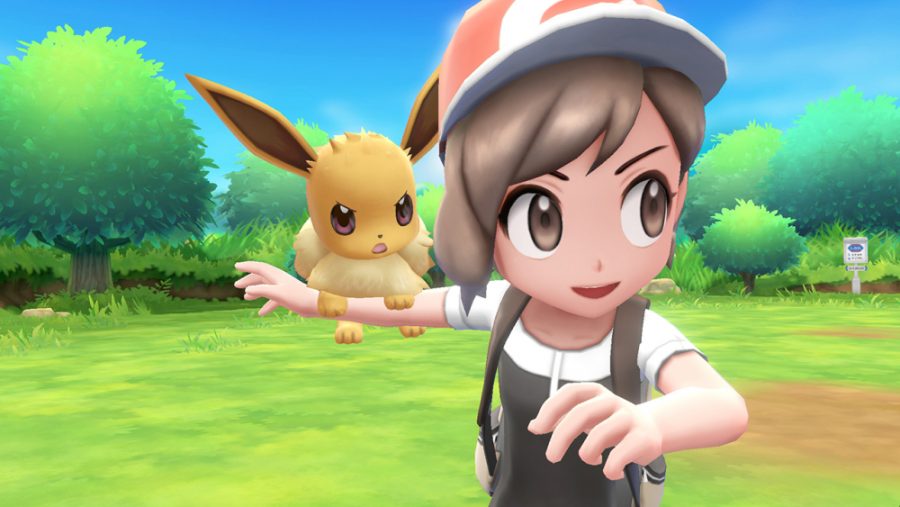Never has a Pokémon game had a more divisive reaction than “Let’s Go, Pikachu!” and “Let’s Go, Eevee!,” released earlier this month. For many unfamiliar with the franchise in recent years, the idea of a streamlined introductory experience was very appealing. For numerous long-term fans of the franchise, however, the premise of “Pokémon: Let’s Go” flew in the face of progress for a series that has stalled more and more with each consecutive entry.
Despite many blemishes and half-successes that “Let’s Go” presents, it’s evident that a lot of love and care went into creating the game. References to previous games are everywhere. Familiar story beats are dressed up with cinematic cutscenes that hold real emotional weight. Extensive voice acting and expressions give you a real sense of attachment to your partner of Eevee or Pikachu. You can choose Pokémon from your party to follow your character around and even ride on some of the larger ones.
That said, “Let’s Go” feels like a culmination of nearly every frustrating aspect of the core Pokémon games in recent years. Developer Game Freak is trying to amend an experience that never needed much fixing in the first place. The game excessively holds the player’s hand, eschewing many of the puzzle-solving elements of the original games in favor of blatantly telling the player how to progress in the story. Your rival lacks the characterization of previous counterparts and instead exists only to congratulate the player every chance they get. Catching Pokémon has been oversimplified into the shallow aim-and-throw motion control minigame from “Pokémon GO,” while breeding, held-item and ability mechanics have been removed entirely.
Previous “Pokémon” games simultaneously offered an understandable basis of gameplay while offering deeper, more complex mechanics if the player desired to engage them. “Let’s Go” focuses entirely on the casual side, taking the choice out of the player’s hands. It’s a good thing that even a casual “Pokémon” experience can be as fun as it is.
In terms of core gameplay, I was pleasantly surprised to find that “Let’s Go” had a well-developed campaign that wasn’t as ridiculously easy as many had feared. The classic RPG elements of capturing Pokémon and engaging in turn-based battles to train them return.
The game even offers a decently fleshed-out challenge due to the establishment of perhaps the most well-constructed level curve ever seen in a Pokémon game. If the player progresses through the game at an average pace, opponents will always be on par with or just above the level of your own Pokémon, adding a layer of complexity to battles that forces the player to think more strategically than just spamming one move until a battle ends. It’s nothing that will stop a player from progressing due to difficulty, but it presents some depth to the battling system.
The visibility of wild Pokémon in the overworld is a welcome change from the frequently annoying random encounters of the past. However, the substantial focus on catching a large number of creatures and shipping them off in exchange for items makes Pokémon feel a little less like partners with and more like a form of currency. The two-player co-op mode essentially breaks the game, turning every battle into a 2-on-1 and throwing any sense of difficulty out the window. The fact that the second player cannot even truly interact with the world on their own cements the feature as a lackluster addition that thankfully doesn’t hurt too much, since it’s optional.
The presentation of the game is perhaps the most notable aspect of “Let’s Go.” The graphics are gorgeous, instantly establishing it as the most visually appealing game in the franchise so far. The novelty of seeing familiar locales and battles in high definition definitely contributed to a large part of my enjoyment. That being said, when compared to flagship titles for other franchises on the Nintendo Switch like “The Legend of Zelda: Breath of the Wild” and “Super Mario Odyssey,” it feels as though Game Freak could have done so much more with the graphical capabilities of the system. Even more frustrating is the fact that the game’s frame rate actually decreases in certain areas.
“Let’s Go” may not do much to innovate, but it celebrates Pokémon’s legacy in a way that will touch any player even vaguely familiar with the franchise. If nothing else, it’s a satisfyingly small-scale precursor to next year’s hopefully much more ambitious entries.
Email Ethan Zack at [email protected].























































































































































